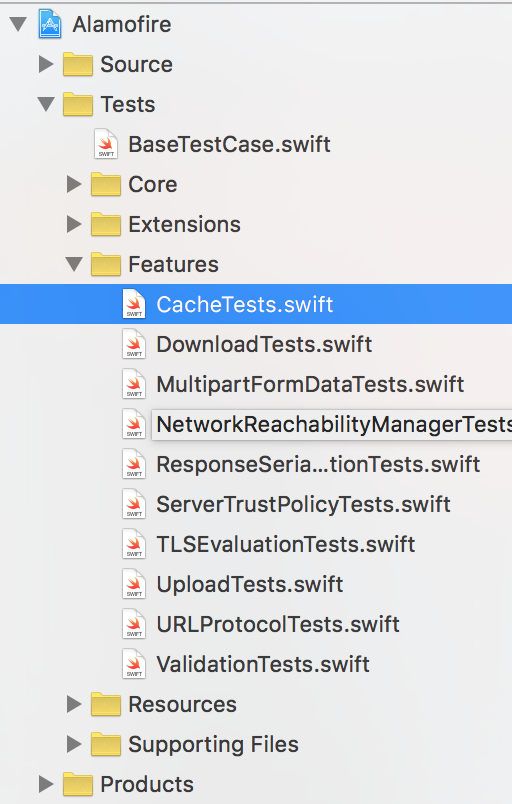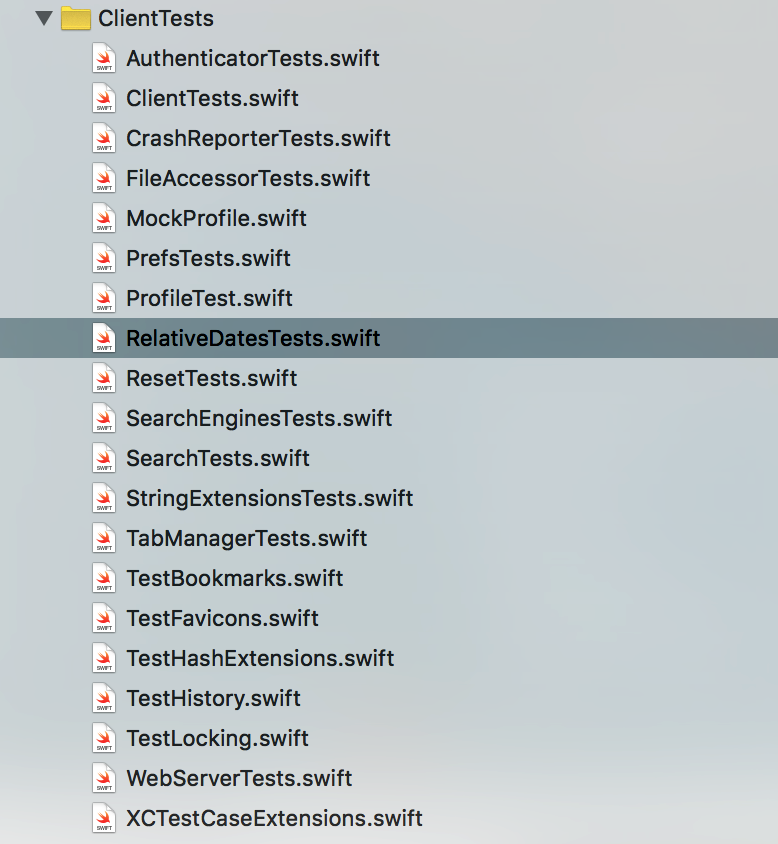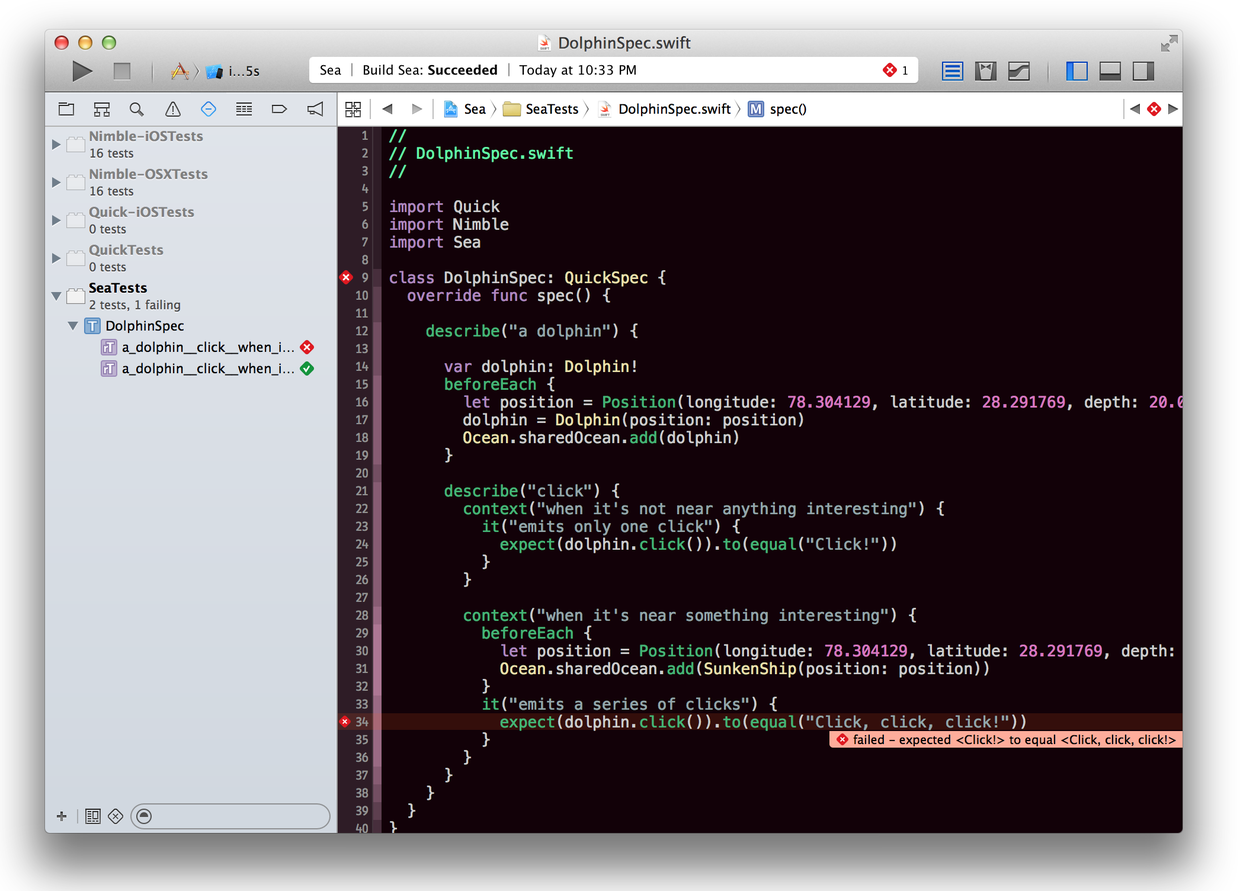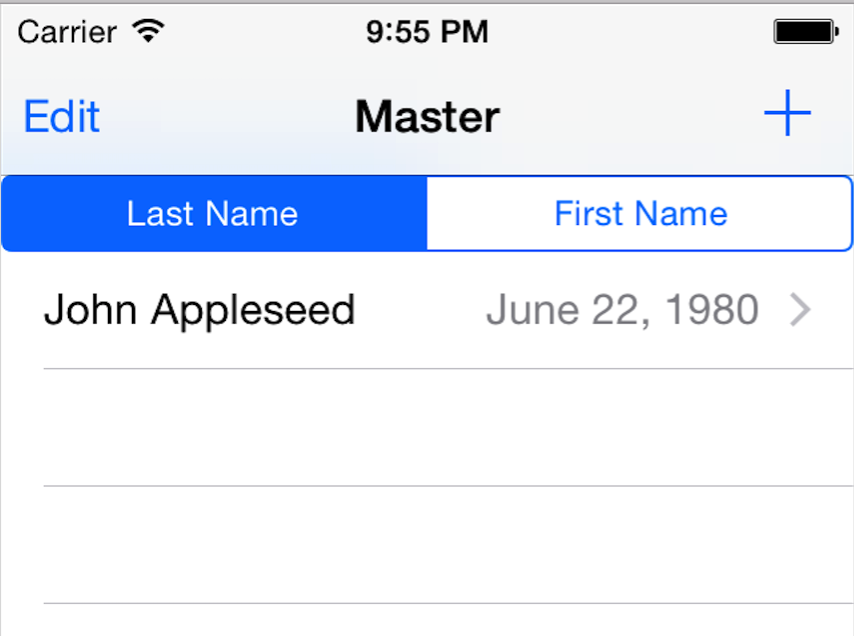swift在iOS开发中越来越普及,大家都认同swift将是iOS的未来,从objc切换到swift只是时间问题。但是,对于老的objc项目,特别是开发积累了2、3年的老项目,从objc转换到swift,基本上不太现实。
那么,如何在老项目中使用swift呢?我想起了单元测试。单元测试,完全是使用另外的target,只要正确配置,基本上不会影响到主target。所以,在单元测试中,我们可以大胆且开心地使用swift,hooray~~~
那么,为什么要写单元测试?有些人,可能觉得搞单元测试,要花更多的时间,写更多的代码,感觉不划算。但是,单元测试也有如下一些优点:
· 使你自己更自信。
· 代码不会退化。你不会因为修改了一个bug,而导致另外的bug。
· 有良好的单元测试,可以进行大胆的重构了。
· 良好的单元测试,本身就是使用说明,有时比文档更有用。
现在很多开源库、开源项目,都加了单元测试,如AFNetworking的swift版本,Alamofire,就写了大量的测试代码:

较复杂的开源项目,如firefox-ios,也会写一些测试代码:

可以认为没有单元测试的开源项目,都是在耍流氓,:)
单元测试中的基本概念
TDD
TDD(Test Drive Development),指的是测试驱动开发。我们一般的想法是先写产品代码,而后再为其编写测试代码。而TDD的思想,却是先写测试代码,然后再编写相应的产品代码。
TDD中一般遵从red,green,refactor的步骤。因为,先编写了测试代码,而还未添加产品代码,所以编译器会给出红色报警。而后,你把相应的产品代码添加上后,并让它通过测试,此时就是绿色状态。如此反复直到各种边界和测试都进行完毕,此时我们就可以得到一个很稳定的产品。因为产品都有相关的测试代码,所以我们可以大胆进行重构,只要保证项目最后是绿色状态,就说明重构不会有问题。
TDD的过程,有点像脚本语言的交互式编程,你敲几行代码,就可以检查下结果,如果结果不对,则要把最近的代码进行重写,直到结果正确为止。
BDD
BDD(Behavior Drive Development),行为驱动开发。它是敏捷中使用的测试方法,它提倡使用Given...When...Then这种类似自然语言的描述来写测试代码。如,Alamofire中下载的测试:
func testDownloadClassMethodWithMethodURLHeadersAndDestination() {
// Given
let URLString = "https://httpbin.org/"
let destination = Request.suggestedDownloadDestination(directory: searchPathDirectory, domain: searchPathDomain)
// When
let request = Alamofire.download(.GET, URLString, headers: ["Authorization": "123456"], destination: destination)
// Then
XCTAssertNotNil(request.request, "request should not be nil")
XCTAssertEqual(request.request?.HTTPMethod ?? "", "GET", "request HTTP method should be GET")
XCTAssertEqual(request.request?.URLString ?? "", URLString, "request URL string should be equal")
let authorizationHeader = request.request?.valueForHTTPHeaderField("Authorization") ?? ""
XCTAssertEqual(authorizationHeader, "123456", "Authorization header is incorrect")
XCTAssertNil(request.response, "response should be nil")
}
Mock
Mock让你可以检查某种情况下,一个方法是否被调用,或者一个属性是否被正确设值。比如,viewDidLoad()后,某些属性是否被设值。
objc下可以使用OCMock来mock对象。但是,由于swift的runtime比较弱,所以,swift上一般要手动写mock。
Stub
如果你跟别人协同开发时,别人的模块还没有完成,而你需要用到别人的模块,这时,就要用到Stub。比如,后端的接口未完成,而你的代码已经完成了。Stub可以伪造了一个调用的返回。
ojbc下可以使用OHHTTPStubs来伪造网络的数据返回。swift下,仍要手动写stub。
使用Quick+Nimble实现BDD
为什么使用Quick
上面Alamofire的例子中,它使用的是苹果的XCTest,所以你会看到它会写很长的函数名,每个Assert,后面还要写很长的注释。
而Quick库,写起来是这样子的:

它更符合BDD的思想,再配合Nimble这个expect库,出错提示也不用写,它自动生成的错误提示已经很可读了。
另外,相比于其他BDD库,它是纯swift写的,可以更方便地用来测试objc代码、swift代码。
注:目前也有很多开源项目,把测试从第三方BDD库换回到XCTest了,可能更看重XCTest的原生性,所以测试库的选择还是看个人了。
使用Cocoapods导入库
我们要使用Quick和Nimble库,可以使用Cocoapods进行管理。在Podfile中添加如下代码:
use_frameworks!
def testing_pods
pod 'Quick', '~> 0.9.0'
pod 'Nimble', '3.0.0'
end
target 'MyTests' do
testing_pods
end
注: swift库在Podfile中,必须使用 use_frameworks!。但是,Cocoapods在这种情况下,会把所有的其他库也变成Frameworks动态库的方式。如果,你为了兼容,仍需要使用.a的静态库,则发布时,记得要注释掉该行。
Quick使用
Quick的使用很简单,基本上上面的那张图已经可以涵盖了。基本上类似如下:
describe("a dolphin") {
describe("its click") {
context("when the dolphin is near something interesting") {
it("is emitted three times") {
// expect...
}
}
}
}
另外,对每个group,可以添加beforeEach和afterEach,来进行setup和teardown(还是可以看上面那张图中的例子)。
使用Nimble进行expect
Quick中的框架看起来很简单。稍微麻烦的是expect的写法。这部分是由Nimble库完成的。
Nimble一般使用 expect(...).to 和 expect(...).notTo的写法,如:
expect(seagull.squawk).to(equal("Oh, hello there!"))
expect(seagull.squawk).notTo(equal("Oh, hello there!"))
Nimble还支持异步测试,简单如下这样写:
dispatch_async(dispatch_get_main_queue()) {
ocean.add("dolphins")
ocean.add("whales")
}
expect(ocean).toEventually(contain("dolphins"), timeout: 3)
你也可以使用waitUntil来进行等待。
waitUntil { done in
// do some stuff that takes a while...
NSThread.sleepForTimeInterval(0.5)
done()
}
下面详细列举Nimble中的匹配函数。
等值判断
使用equal函数。如:
expect(actual).to(equal(expected))
expect(actual) == expected
expect(actual) != expected
是否同一个对象
使用beIdenticalTo函数
expect(actual).to(beIdenticalTo(expected))
expect(actual) === expected
expect(actual) !== expected
比较
expect(actual).to(beLessThan(expected))
expect(actual) < expected
expect(actual).to(beLessThanOrEqualTo(expected))
expect(actual) <= expected
expect(actual).to(beGreaterThan(expected))
expect(actual) > expected
expect(actual).to(beGreaterThanOrEqualTo(expected))
expect(actual) >= expected
比较浮点数时,可以使用下面的方式:
expect(10.01).to(beCloseTo(10, within: 0.1))
类型检查
expect(instance).to(beAnInstanceOf(aClass))
expect(instance).to(beAKindOf(aClass))
是否为真
// Passes if actual is not nil, true, or an object with a boolean value of true:
expect(actual).to(beTruthy())
// Passes if actual is only true (not nil or an object conforming to BooleanType true):
expect(actual).to(beTrue())
// Passes if actual is nil, false, or an object with a boolean value of false:
expect(actual).to(beFalsy())
// Passes if actual is only false (not nil or an object conforming to BooleanType false):
expect(actual).to(beFalse())
// Passes if actual is nil:
expect(actual).to(beNil())
是否有异常
// Passes if actual, when evaluated, raises an exception:
expect(actual).to(raiseException())
// Passes if actual raises an exception with the given name:
expect(actual).to(raiseException(named: name))
// Passes if actual raises an exception with the given name and reason:
expect(actual).to(raiseException(named: name, reason: reason))
// Passes if actual raises an exception and it passes expectations in the block
// (in this case, if name begins with 'a r')
expect { exception.raise() }.to(raiseException { (exception: NSException) in
expect(exception.name).to(beginWith("a r"))
})
集合关系
// Passes if all of the expected values are members of actual:
expect(actual).to(contain(expected...))
expect(["whale", "dolphin", "starfish"]).to(contain("dolphin", "starfish"))
// Passes if actual is an empty collection (it contains no elements):
expect(actual).to(beEmpty())
字符串
// Passes if actual contains substring expected:
expect(actual).to(contain(expected))
// Passes if actual begins with substring:
expect(actual).to(beginWith(expected))
// Passes if actual ends with substring:
expect(actual).to(endWith(expected))
// Passes if actual is an empty string, "":
expect(actual).to(beEmpty())
// Passes if actual matches the regular expression defined in expected:
expect(actual).to(match(expected))
检查集合中的所有元素是否符合条件
// with a custom function:
expect([1,2,3,4]).to(allPass({$0 < 5}))
// with another matcher:
expect([1,2,3,4]).to(allPass(beLessThan(5)))
检查集合个数
expect(actual).to(haveCount(expected))
匹配任意一种检查
// passes if actual is either less than 10 or greater than 20
expect(actual).to(satisfyAnyOf(beLessThan(10), beGreaterThan(20)))
// can include any number of matchers -- the following will pass
expect(6).to(satisfyAnyOf(equal(2), equal(3), equal(4), equal(5), equal(6), equal(7)))
// in Swift you also have the option to use the || operator to achieve a similar function
expect(82).to(beLessThan(50) || beGreaterThan(80))
测试UIViewController
触发UIViewController生命周期中的事件
· 调用 UIViewController.view, 它会触发 UIViewController.viewDidLoad()。
· 调用 UIViewController.beginAppearanceTransition() 来触发大部分事件。
· 直接调用生命周期中的函数
手动触发UIControl Events
describe("the 'more bananas' button") {
it("increments the banana count label when tapped") {
viewController.moreButton.sendActionsForControlEvents(
UIControlEvents.TouchUpInside)
expect(viewController.bananaCountLabel.text).to(equal("1"))
}
}
例子
例子使用 参考资料5中的例子。我们使用Quick来重写测试代码。
这是一个简单的示例,用户点击右上角+号,并从通讯录中,选择一个联系人,然后添加的联系人就会显示在列表中,同时保存到CoreData中。

为了避免造成Massive ViewController,工程把tableView的DataSource方法都放到了PeopleListDataProvider这个单独的类中。这样做,也使测试变得更容易。在PeopleListViewController这个类中,当它选择了联系人后,会调用PeopleListDataProvider的addPerson,把数据加入到CoreData中,同时刷新界面。
为了测试addPerson是否被调用,我们要Mock一个DataProvider,它只含有最简化的代码,同时,在它的addPerson被调用后,设置一个标记addPersonGotCalled。代码如下:
class MockDataProvider: NSObject, PeopleListDataProviderProtocol {
var addPersonGotCalled = false
var managedObjectContext: NSManagedObjectContext?
weak var tableView: UITableView?
func addPerson(personInfo: PersonInfo) { addPersonGotCalled = true }
func fetch() { }
func tableView(tableView: UITableView, numberOfRowsInSection section: Int) -> Int { return 1 }
func tableView(tableView: UITableView, cellForRowAtIndexPath indexPath: NSIndexPath) -> UITableViewCell { return UITableViewCell() }
}
接着,我们模拟添加一个联系人,看provider中方法是否被调用:
context("add person") {
it("provider should call addPerson") {
let record: ABRecord = ABPersonCreate().takeRetainedValue()
ABRecordSetValue(record, kABPersonFirstNameProperty, "TestFirstname", nil)
ABRecordSetValue(record, kABPersonLastNameProperty, "TestLastname", nil)
ABRecordSetValue(record, kABPersonBirthdayProperty, NSDate(), nil)
viewController.peoplePickerNavigationController(ABPeoplePickerNavigationController(), didSelectPerson: record)
expect(provider.addPersonGotCalled).to(beTruthy())
}
}
上面只是一个简单地测试ViewController的例子。下面,我们也可以测试这个dataProvider。模拟调用provider的addPerson,则ViewController中的tableView应该会有数据,而且应该显示我们伪造的联系人。
context("add one person") {
beforeEach {
dataProvider.addPerson(testRecord)
}
it("section should be 1") {
expect(tableView.dataSource!.numberOfSectionsInTableView!(tableView)) == 1
}
it("row should be 1") {
expect(tableView.dataSource!.tableView(tableView, numberOfRowsInSection: 0)) == 1
}
it("cell show full name") {
let cell = tableView.dataSource!.tableView(tableView, cellForRowAtIndexPath: NSIndexPath(forRow: 0, inSection: 0)) as UITableViewCell
expect(cell.textLabel?.text) == "TestFirstName TestLastName"
}
}
完整的测试代码,见demo。
补充
进行桥接
因为使用swift去测objc的代码,所以需要桥接文件。如果项目比较大,依赖比较复杂,可以把所有的objc的头文件都导入桥接文件中。参考以下python脚本:
import os
excludeKey = ['Pod','SBJson','JsonKit']
def filterFunc(fileName):
for key in excludeKey:
if fileName.find(key) != -1:
return False
return True
def mapFunc(fileName):
return '#import "%s"' % os.path.basename(fileName)
fs = []
for root, dirs, files in os.walk("."):
for nf in [root+os.sep+f for f in files if f.find('.h')>0]:
fs.append(nf)
fs = filter(filterFunc, fs)
fs = map(mapFunc, fs)
print "".join(fs)
测试不依赖主target
默认运行unit test时,产品的target也会跟着跑,如果应用启动时做了太多事情,就不好测试了。因为测试的target和产品的target都有Info.plist文件,可以修改测试中的Info.plist的bundle name为UnitTest,然后在应用启动时进行下判断。
- (BOOL)application:(UIApplication *)application didFinishLaunchingWithOptions:(NSDictionary *)launchOptions {
NSString *value = [[[NSBundle mainBundle] infoDictionary] valueForKey:@"CFBundleName"];
if ([value isEqualToString:@"UnitTest"]) {
return YES; // 测试提前返回
}
// 复杂操作...
}

